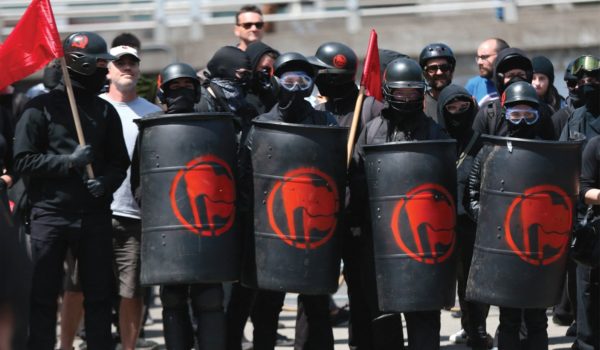

Online battles between far right groups and anti-fascists – or “Antifa” – are now regularly spilling out onto the streets of America. But who are Antifa and what do they represent? Anisa Subedar and Mike Wendling went to the West coast of America to find out for Seriously… podcast Political Violence in America. Here are seven facts you need to know.

1. How long have Antifa been around?
Some Antifa groups date the origins of their movement to fights against European fascists in the 1920s and 1930s. Mark Bray, author of Antifa: The Anti-Fascist Handbook, says the modern American Antifa movement began in the 1980s with a group called Anti-Racist Action. Its members confronted neo-Nazi skinheads at punk gigs in the American Midwest and elsewhere. By the early 2000s the Antifa movement was mostly dormant – until the rise of Donald Trump and the alt-right.
2. How do you pronounce Antifa?
According to Bray, there are multiple different pronunciations. In the United States most people say an-tee-fa. In Europe it’s sometimes referred to as anti-far, which Bray believes has been influenced by the Italian word antifascismo. He says an-tee-fa but doesn’t correct people who pronounce it differently.
3. What are they opposed to?
Neo-Nazis, Neo-fascism, white supremacists and racism, and these days the movement that encapsulates some of those ideas: the alt-right.
We spoke to secret Antifa groups in Oregon. They said they come from a variety of political backgrounds but they were united in their opposition to fascism, and they have an anti-government streak. They said they see creeping authoritarianism in the current American administration that they are looking to build “a movement that really insulates us from the policies of Donald Trump”.
“It’s not just resisting the federal administration but also resisting moves that can lead to fascism,” one member told us, “and those happen locally whether from local officials or from local alt-right movements.”
4 Why do they all dress in black?
Like other protest movements dating back to Cold War era West German anarchists, Antifa supporters will often dress all in black, sometimes covering their faces with masks or helmets so they can’t be identified by opposing groups or the police. It’s an intimidating tactic – known as a “black bloc” – which also allows them to move together as one anonymous group. There are also offshoots – one Antifa group in Oregon said they also have a “snack bloc” of people who provide food and water for their allies during protests.

5. What tactics do they use?
Antifa look to disrupt alt-right events and far-right speakers. They use a variety of tactics to do this – including shouting and chanting and forming human chains to block off right-wing demonstrators. Some are unapologetic about their online tactics, which include monitoring the far right on social media. They also release personal information about their opponents online, commonly known as “doxxing” – they’ve gotten some alt-right supporters fired from their jobs after identifying them online.
Antifa groups also use more traditional forms of community organising like rallies and protest marches. The most extreme factions will carry weapons like pepper spray, knives, bricks and chains – and they don’t rule out violence.
6: How violent are they?
Their willingness to use violence marks out Antifa from many other left-wing activists, although the Antifa members we spoke to said they denounce the use of weapons and violent direct action. They said if violence does occur, it’s as a form of self-defence. They also make historical arguments to justify their position. For instance, they ask, what if opponents of the German Nazi Party had been more forceful in their opposition in the 1930s, could World War Two and the Holocaust have been averted?
Antifa have been directly and sometimes physically confronting the far right on the streets and, in some cases, they have been successful in postponing, cutting short or cancelling rallies and speeches up and down America.
7. Do women join Antifa groups?
Traditionally direct street action has been a mostly male domain, but significant numbers of women are members of Antifa groups and have been arrested at counter-demonstrations against the alt-right in California and elsewhere. Female members of Antifa groups told us they view the current administration as being anti-women. They point to White House policies on immigration, affordable health care, abortion rights and voting rights and say they disproportionately affect women and minorities. We spoke with Sunsara Taylor from the Antifa group Refuse Fascism who told us women are motivated to respond to “what hits them”.
Source: BBC
more recommended stories
 Fentanyl Seizures at Border Continue to Spike, Making San Diego a National Epicenter for Fentanyl Trafficking
Fentanyl Seizures at Border Continue to Spike, Making San Diego a National Epicenter for Fentanyl TraffickingFentanyl Seizures at Border Continue to.
 Utah Man Sentenced for Hate Crime Attack of Three Men
Utah Man Sentenced for Hate Crime Attack of Three MenTuesday, August 8, 2023 A.
 Green Energy Company Biden Hosted At White House Files For Bankruptcy
Green Energy Company Biden Hosted At White House Files For BankruptcyAug 7 (Reuters) – Electric-vehicle parts.
 Former ABC News Reporter Who “Debunked” Pizzagate Pleads Guilty of Possessing Child pδrn
Former ABC News Reporter Who “Debunked” Pizzagate Pleads Guilty of Possessing Child pδrnFriday, July 21, 2023 A former.
 Six Harvard Medical School and an Arkansas mortuary Charged With Trafficking In Stolen Human Remains
Six Harvard Medical School and an Arkansas mortuary Charged With Trafficking In Stolen Human RemainsSCRANTON – The United States.
 Over 300 People Facing Federal Charges For Crimes Committed During Nationwide Demonstrations
Over 300 People Facing Federal Charges For Crimes Committed During Nationwide DemonstrationsThe Department of Justice announced that.
